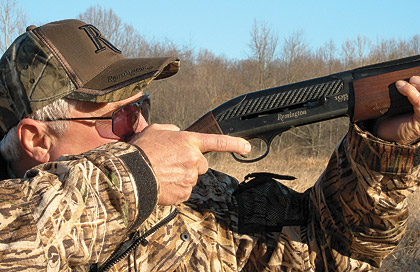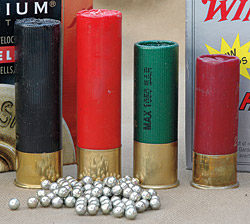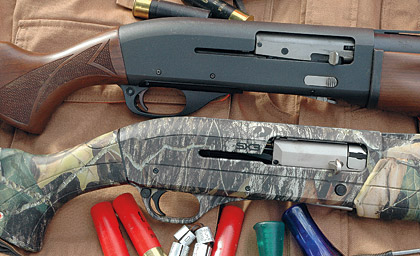Weight, action and load compatibilty are all factors...
By Layne Simpson
 A gas-operated shotgun is more comfortable to shoot with heavy waterfowl loads than a pump gun because it is usually heavier and tends to lengthen the recoil curve a bit. |
There was a time when most hunters used the same shotgun for everything, from shooting quail to dropping a bouncing cottontail to ground-slicing a turkey gobbler to slipping a "punkin' ball" between the ribs of a deer. Many also used their hunting guns when shooting clay targets, and while some of us still do, most who take those games seriously use guns built specifically for the sport.
In fact, the entire hunting and shooting world has been taken over by specialty firearms, and nowhere is this more evident than in shotguns. We have skeet guns, trap guns, sporting clays guns, quail guns, pheasant guns, turkey guns, deer guns, pretty guns, ugly guns and about everything else you can think of. If we don't have it now, just wait until next year.
And we also have waterfowl guns. Truth be told, we really don't need what is now commonly referred to as a waterfowl gun, simply because some of the guns we've used for years for shooting pheasants and other large game birds will kill a duck or goose just as dead. But there are certain characteristics that make some guns better than others, so let's take a look at them.
For starters, if a gun is to be used for a lot of waterfowling, it must be built to handle steel shot. This usually means it was made after the use of steel shot in the wetlands became mandatory during the mid-1980s.
There are alternatives to steel for older guns, with excellent examples such as Classic Doubles from Environ-Metal and Tungsten Matrix from Kent Cartridge, and while many of us occasionally use them in our vintage fowling pieces, they are quite a bit more expensive than steel.
As much as some hunters dislike steel shot, we all have to admit the cost factor makes it the logical choice for most of us. I will also add that the performance of steel shot loads has improved immensely over the past decade or so.
 When using steel shot, the 10-gauge and 3½-inch, 12-gauge shells are better for goose hunting than shorter shells because they hold more large pellets, like the triple-Bs shown here. From left to right: 10 gauge; | 3½-inch 12 gauge; | 3-inch 12 gauge, | 2¾-inch 12 gauge. |
As I have written in these pages before, in order to deliver the same energy to the target with steel as with lead shot, we must move up a couple of pellet sizes. In other words, where we used to use No. 2 lead on geese, we now use single-B and sometimes larger. I actually prefer double-B on geese and have also had good results from triple-B.
In order to squeeze enough of those bigger pellets into a shotshell to enjoy decent pattern density, we need one with lots of room inside. The 3-inch, 20-gauge shell holds enough pellets for shooting ducks at close range over decoys, but for bigger birds and greater distances, something bigger is needed. The 16 gauge has the potential of being better, but very few steel shot loads are available for it, and over the past few years they became virtually nonexistent. This leaves us with the 12 gauge.
The 2¾ inch, 12-gauge shell holds enough pellets for shooting ducks and geese at relatively close range and is a better choice for geese than the 3-inch 20 because it is available with larger shot. But for greater distances, a longer shell is a better option.
The 3-inch shell is presently the No. 1 choice among waterfowlers, but with so many guns now chambered for the 3½ incher, it is quickly gaining ground. I wouldn't be surprised to see it eventually surpass the popularity of the 3-inch shell among waterfowlers.
 The dull finish on this Remington SP-10 at rear isn't as likely to cause incoming birds to flare as a shiny one. Same goes for the camo finish on this Winchester SX3, which also protects the metal from rusting. |
For other activities, like shooting a turkey gun from the sit, I have absolutely no use for the Roman candle of 12-gauge shotshells due to the recoil, but for all-around shooting of everything from the seemingly bulletproof common eider to the biggest of geese at all reasonable distances, it is the best thing going simply because it holds as much steel shot as a 10-gauge shell. For shooting most ducks, I would just as soon have the 3-inch shell, but when it comes to throwing a handful of triple-Bs at a distant Canada, its longer cousin is the way to go, as it holds more of those huge, bird-folding pellets.
Regardless of which shotshell you choose, heavy waterfowl loads generate plenty of recoil. Due to its ability to function reliably when subjected to the worst of conditions, the old slide (pump) action is still an excellent choice, but since it is lighter than most autoloaders, it also kicks harder. Recoil can be reduced by increasing gun weight and, if done properly, it will have little effect on its handling.
Removing the recoil pad and drilling a couple of large holes in the stock and filling them with lead shot accomplishes that, or if you want to get fancy, pack the holes with mercury-filled recoil reducers.
After adding weight to the stock, the gun will likely feel too muzzle-light; take care of this issue by adding weight to the barrel just forward of the forearm. Clamp-on weights designed for this purpose are available from Brownells and other suppliers of gizmos and gadgets for trap shooters.
The gas-operated shotgun is probably the most popular type used by waterfowlers today because they are often more comfortable to shoot than the typical pump gun, as the gun is usually heavier, and its gas operation lengthens the recoil curve.
There was a time when recoil-operated shotguns kicked harder than gas guns, and while this continues to be true for an older design such as the Browning Auto-5, it no longer is for more modern guns. As I explained in this column a few issues back, I find the new Benelli Vinci to be as comfortable to shoot as any gas-operated shotgun of the same weight.
Some manufacturers go beyond the simple recoil pad by modifying the stock in various ways and soaking up some of the recoil generated by heavy waterfowl loads. Slots containing rubber chevrons on the wall of the ComforTech stock developed by Benelli allow it to flex enough to absorb some of the recoil. In addition to using that stock a lot in the field, I have seen it flex during recoil when captured by a slow-motion camera.
A rubber insert in the comb of that stock also adds to shooter comfort because a lot of what we perceive as recoil from a shotgun comes when its stock rises into the shooter's cheek. The Kick-Off option on the stocks of some Beretta guns also does a good job of reducing recoil.
Shiny guns have killed lots of ducks and geese through the years, but a dull finish on wood and metal is better because it eliminates light reflection that can be spotted by incoming waterfowl.
Camouflage finishes on shotguns are quite popular, and while I don't believe they are less likely to be spotted by incoming birds than a less-expensive dull finish, they do offer protection against rusting, and this is important on a gun that will be continually exposed to rainy days and wet dogs.
My favorite goose gun is the Remington SP-10 in 10 gauge. At 10¾ pounds, it is too heavy for a lot of walking, but I don't do a lot of walking when waterfowling, anyhow.
I especially like it for shooting geese because the 10-gauge shell holds as many big pellets as the 3½ inch 12 gauge, yet the weight of the gun makes it far more comfortable to shoot with heavy loads than any 12-gauge gun I have tried.
Anyone who has shot while sitting in a layout blind knows how some guns and loads can eventually drive you into the ground like a tent stake. It doesn't happen with Remington's Big Ten.






